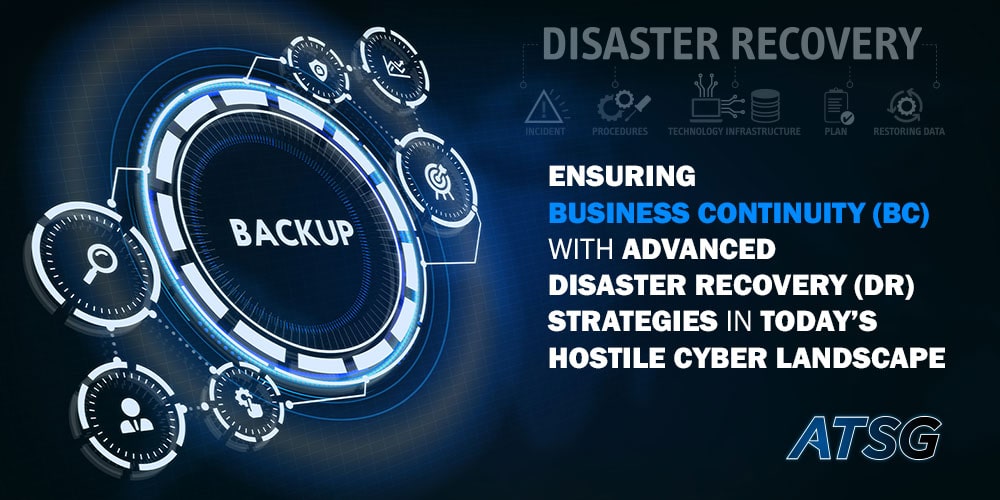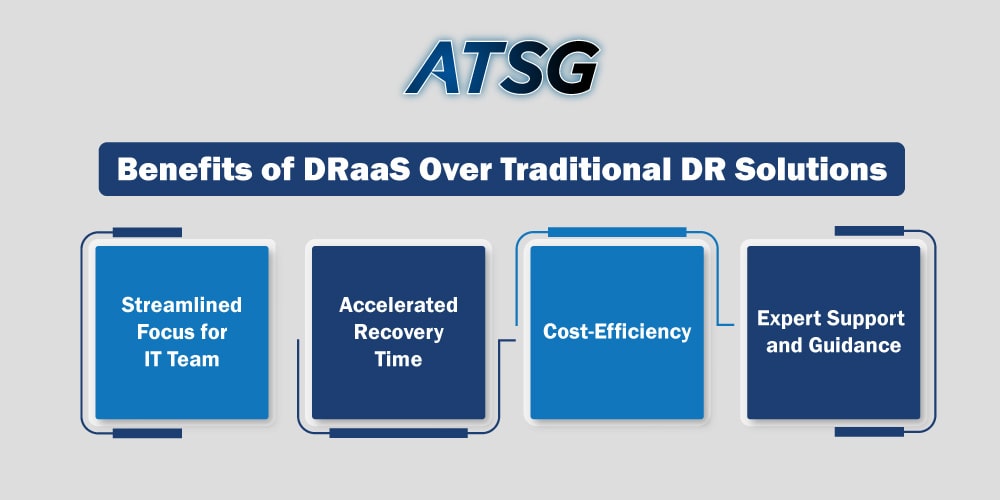In an age where cyber threats are evolving at an unprecedented rate, safeguarding business continuity has never been more critical. This comprehensive guide delves into the complexities of the current cyber threat landscape and underscores the importance of advanced Disaster Recovery (DR) strategies.

Understanding the Current Cyber Threat Landscape
In the last ten years, there has been a significant surge in cyber risks globally. The era of digital advancement has not only opened doors for innovation and progress, but has also paved the way for cybercriminals to capitalize on the weaknesses in these new avenues. The emergence of novel technologies, like artificial intelligence (AI), has emboldened attackers to refine their techniques.
Most Prevalent Cyber Threats Targeting Enterprises
1. Ransomware
Ransomware can prove highly detrimental for an organization, as it remains susceptible to the attacker’s whims, lacking adequate insurance against such scenarios, unless a substantial sum is paid. Furthermore, even after the ransom is paid, certain attackers deliberately create a hidden entry point or “back-door”, leaving room for the possibility of a subsequent breach. This elevated level of sophistication within the realm of ransomware has elevated it to the status of being one of the most highly evolved and notorious forms of cyber threats.
2. Identity Theft
Identity theft constitutes a form of cybercrime, wherein a user’s identity is maliciously attained by extracting their usernames and passwords. Following a successful acquisition of these credentials, the perpetrator can assume the guise of the user’s account, and further infiltrate the organization’s data or systems. Cybercriminals can attain remote entry to systems, by exploiting valid passwords to login third-party services as well. With the rise in remote work practices, organizations have encountered a surge in instances of credential theft attacks, thereby compromising both data confidentiality, and user security.
3. Malware
This malicious software is crafted with specific objectives in mind, and the “ingenuity” of hackers and cybercriminals knows no bounds. Its purposes include pilfering information, causing operational disruptions, and extorting payments. Malware stands as a serious attack vector, capable of morphing cyber threats in ways that have the potential to imperil an organization.
4. Distributed Denial of Service (DDoS)
Cyber perpetrators initiate campaigns with diverse objectives, including launching Distributed Denial of Service (DDoS) attacks that are aimed at overwhelming the victim’s systems, with an excessive influx of fictitious traffic from numerous sources, rendering them unable to process legitimate traffic.
The Impact of Cyber Threats on Business Continuity (BC)
In the present digital era, businesses find themselves increasingly susceptible to cyber attacks, which carry the potential for data breaches, financial setbacks, and harm to their reputation. Faced with these looming dangers, it has become imperative for businesses to accord high priority to cybersecurity as an integral component of their continuity planning. Certain forms of cybercrime have the potential to permanently incapacitate a business.
This reality underscores the recommendation by industry experts that devising a business continuity (BC) plan, specifically tailored to address cyber risks is essential, supplementing the plans that are likely already in place to manage other types of disasters. The most prudent course of action a company can take to enhance its ability to recover from a cybersecurity incident is to establish a detailed strategy for such occurrences.
Fundamentals of DRaaS: Beyond Traditional Disaster Recovery
Key Components of DRaaS
1. Automated Failover and Failback
Consider failover and failback procedures as essential supplementary components within a resilient disaster recovery (DR) framework. The failover process involves transitioning production activities from a primary site, to a designated backup or recovery site. Conversely, the failback process entails re-instating production operations to either the original, or a new primary location, once a disaster or a planned event has been successfully addressed.
2. Continuous Data Protection
This particular feature is an important aspect of disaster recovery (DR) plans that enables backing up data on a computer system, every time a change is made. Continuous data protection maintains a continuous journal of data changes, and makes it possible to restore a system to any previous known state. It also solves the issue of a “backup window”, where organizations are at risk of losing data that was created.
3. Geographically Distributed Recovery Sites
Disaster recovery (DR) involves strategies and measures implemented to swiftly restore systems, data, and operations after a disruptive event. Geographically Distributed Recovery Sites refer to having backup and recovery infrastructure spread across multiple locations, which helps enhance resilience by minimizing the impact of regional disruptions, and enabling efficient failover and failback capabilities.
Benefits of DRaaS Over Traditional DR Solutions

1. Streamlined Focus for IT Team
When the internal IT team shoulders the responsibilities of maintaining, testing, and providing IT support for disaster recovery plans, their bandwidth to attend to other critical IT functions diminishes. Adopting Disaster Recovery as a Service (DRaaS) simplifies IT management, liberating your IT staff to concentrate on their core competencies.
2. Accelerated Recovery Time
In the realm of disaster recovery (DR) planning, businesses cannot afford delays, and need to be proactive. DRaaS eradicates the need for prolonged waiting periods, while hardware installations and testing processes unfold.
3. Cost-Efficiency
Internal disaster recovery initiatives often come with substantial costs, mainly due to recurring expenses tied to maintenance and IT support. While DRaaS does entail an initial investment, it ultimately leads to cost reduction over the long run.
4. Expert Support and Guidance
Reputable service providers, like ATSG, typically possess greater expertise in data security and disaster recovery planning compared to in-house teams, owing to the specialized nature of their services. In times of crisis, adept providers swiftly and efficiently manage issues, as and when they arise.
Cost Implications and ROI of Implementing DRaaS
The cost implications of disaster recovery can vary significantly, based on a variety of factors, including the size of the organization, the complexity of the IT infrastructure, the chosen disaster recovery strategy, and the specific technologies and services employed. The cost implications of disaster recovery can range from initial setup expenses to ongoing operational costs. It’s crucial for organizations to conduct a thorough cost-benefit analysis that considers their specific requirements, risk tolerance, and available budget, to determine the most suitable disaster recovery (DR) approach.
Network Considerations for DRaaS Implementation
WAN Optimization and Traffic Management
WAN plays a crucial role in enhancing the disaster recovery (DR) posture. It optimizes the efficiency of Wide Area Network (WAN) connections, which are often used to replicate data, and maintain communication in data centers during disaster recovery scenarios.
Secure Data Transmission Protocols
These play a vital role in disaster recovery, by safeguarding the integrity and confidentiality of data during its transit. These protocols, such as SSL, TLS, SSH, and IPsec, establish encrypted channels for data exchange, shielding it from un-authorized access and potential breaches. In the context of disaster recovery, employing these protocols ensures that critical information remains protected while being transferred between primary and secondary data centers, enhancing the overall security posture of the recovery process.
Best Practices for Implementing DRaaS Strategies
Having a comprehensive disaster recovery (DR) plan that can be executed calmly during emergencies is crucial to maintaining accessible IT services, when they are most needed. This is where Disaster Recovery as a Service (DRaaS) comes into play.
Assessing and Prioritizing Critical Business Applications
The evaluation and ranking of essential business applications in disaster recovery planning is a vital step in ensuring effective continuity. This process involves identifying key applications, and determining their significance to the organization’s operations.
By classifying these applications based on their criticality, businesses can allocate resources and efforts according to priority. This approach guarantees that during a disaster, the most crucial applications are promptly restored and operational, minimizing downtime and mitigating potential losses.
Regularly Testing and Validating DRaaS Solutions
Consistently testing and validating your disaster recovery plan is essential to ensure its effectiveness and reliability. By regularly conducting tests and validations, you can identify potential weaknesses, fine-tune processes, and enhance your organization’s readiness to respond to unforeseen cybersecurity incidents.
This approach helps uncover vulnerabilities and gaps in your disaster recovery plan. It allows you to address these issues, before they become critical during an actual disaster. Testing also provides insights on how long it takes to restore critical systems and applications. This helps set realistic recovery time objectives (RTOs) and recovery point objectives (RPOs)
Ensuring Compliance and Regulatory Standards with DRaaS
Ensuring compliance with regulatory standards is a critical aspect of disaster recovery planning. Adhering to these standards is essential for businesses to operate legally, protect sensitive data, and maintain the trust of customers and other key stakeholders.
Incorporating the specific requirements of applicable regulations within your disaster recovery plan is vital. Moreso, maintaining detailed documentation of how your disaster recovery plan adheres to regulatory standards is also crucial. By aligning your disaster recovery plan with regulatory standards, you not only mitigate legal risks, but also demonstrate a commitment to data protection and security, which can enhance your organization’s reputation and credibility.
The Future of DRaaS – Innovations and Trends on the Horizon
Integration of AI and Machine Learning (ML) in DRaaS
AI has brought about a transformative shift in the landscape of Disaster Recovery as a Service (DRaaS), leading to swifter and more precise disaster recovery outcomes. Through AI, enterprises can mechanize the tasks of risk detection, risk mitigation, prediction of potential disasters, and taking preemptive measures.
In parallel, Machine Learning (ML) plays a pivotal role in the DRaaS sphere, by augmenting the precision and efficiency of disaster recovery protocols. ML empowers businesses to automate the intricate stages of data backup and recovery, which effectively curbs the likelihood of human errors.
By automating and optimizing disaster recovery workflows, organizations can significantly curtail downtime, reduce data loss, and fortify their overall resilience. The synergy of AI and ML also serves to economize time and resources, by streamlining disaster recovery (DR) procedures, thereby diminishing the need for manual intervention.
Improving Your Cybersecurity Posture with ATSG
Cybersecurity threats are extremely complex and volatile. Therefore, adopting a capable cybersecurity solutions provider can help an enterprise mitigate the threats posed by cyber attacks. To better cope with cyber threats, it has become essential to have reliable technology and IT solutions providers, like ATSG.
With highly professional and certified experts, ATSG offers optimal cybersecurity solutions that can help enterprises navigate present day challenges. Whether simple or complex, the impact of cyber attacks can be catastrophic for an enterprise. Therefore, adopting ATSG’s intelligent cybersecurity solutions can elevate the security posture of an enterprise.




